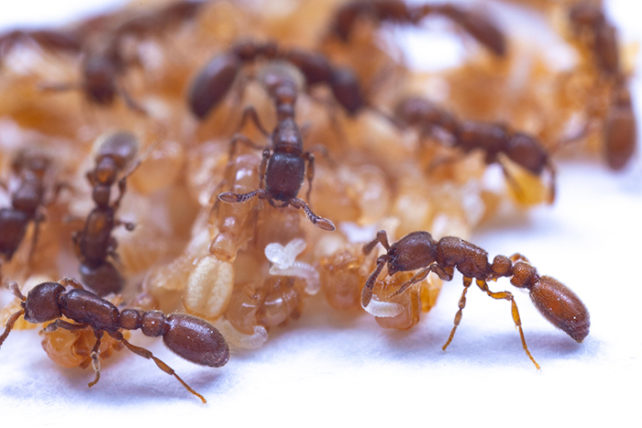There's nothing quite like drinking with friends, and it turns out ants may agree as they have their own form of social drinking too.
But instead of getting on the beers, ants' drink of choice is a kind of nutrient-filled 'milk' that oozes out from their youngsters. The whole colony partakes, from the newest hatchlings to adults.
Ant pupae secrete this liquid in large volumes during a specific phase in their development. It appears to be a cocktail of molting fluids, which include degraded products of the pupa's old cuticle along with the enzymes that break it down. Mmmmm! Delicious!
"The first few days after hatching, larvae rely on the fluid almost like a newborn relies on milk," says Rockefeller University biologist Daniel Kronauer.
"The adults also drink it voraciously and, although it's not clear what it does to the adults, we're confident that it impacts metabolism and physiology."
A study from @DanielKronauer's lab shows that a newly discovered “social fluid” appears to unite ant colonies across developmental stages into one superorganism. #RockefellerScience https://t.co/tnpL0QQZxe pic.twitter.com/77XHaqlzb6
— Rockefeller University (@RockefellerUniv) November 30, 2022
While originally researching how social isolation affected ants, Rockefeller University ethologist Orli Snir and colleagues noticed this drinking ritual. After isolating the pupae from the colony, the researchers manually removed the fluid for some of the baby ants but left the others alone.
The results were striking.
"If we did not remove fluid from isolated pupae under clean rearing conditions, they drowned in their own secretion," the researchers write in their paper.
Other pupae that were kept in used nest boxes, rather than a sterile environment, succumbed to fungi infections. But those who returned back to the colony as soon as their 'milk' emerged had a high rate of survival.
"This shows that, in the colony context, pupae depend on adults to remove the secretion, and would otherwise die," Snir and team conclude.

The baby ants produce their 'milk' during their most seemingly dormant phase of development – while they metamorphose from larvae to adults, right after they gain their pigment. This phase just so happens to coincide with the hatching of the next cohort of larvae.
Using blue food dye, the team was able to show the new hatchlings drank the milk too.
Their adult caretakers carefully pick them up and place them on their older pupae siblings for a drink. If newborn larvae did not receive the fluid in the first few days of life, they were more likely to die.
The team also identified hormones and neuroactive substances in the pupa milk, along with amino acids, sugars, and vitamins.
While the initial experiments were on clonal raider ants (Ooceraea biroi), Snir and colleagues found the same process occurred in at least one species across five major ant subfamilies.
"It probably evolved once, early in ant evolution, or even preceding ant evolution," explains Kronauer.
Individual ants are so interlinked with each other within their colony, they're often likened to collectively functioning as one organism – each social class having a specific role like one type of tissue or organ.
It's unclear how this pupa fluid influences ants' social structure, but the researchers are keen to discover it.
"The way that ants use this fluid creates a dependency between different developmental stages," says Kronauer. "It just shows to what extent ant colonies really operate as an integrated unit."
This isn't the first strange excretion ants have been caught savoring, but it's an astonishing new find given this group of animals has been intensively studied for over a century.
Their research was published in Nature.
